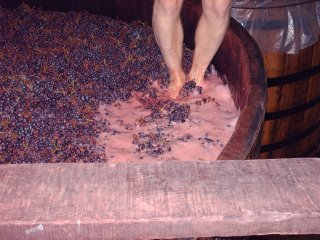In an effort to live up to our marketing departments claims of a 1000 bins on the wine list, I was put in a position where Ive had to list some really quite young wines on the list. Particularly prominent amongst them are the 2003, 2004 and now 2005 clarets that we have in stock. They are causing me something of a dilemma. Do I keep them off the list until they are ready to drink (my prefered option) or do we list them and hope that people will perhaps have enough knowledge to realise that really the wines are not anywhere near ready to drink. Well I kind of lost the arguement and they ended up being listed. So now what do I do when a customer order the wine?
Well this is a situation that I faced tonight. A table of four, amongst them a fairly prominent young chef, with a michelin star to his name. Am I being tested to see if I will pick up on the fact that the wine is a bit on the young side, or perhaps the customer is a wine pedo, he likes his wine young, tannic and under-developed. Im not in the business of correcting customers, and I dont want to offend the guy who ordered the wine, so my tactic is to present the bottle and then offer this gem - " Bearing in mind the youth of the wine, I think it might be prudent to double decant the wine in order to open it up a little bit" The guy shrugs ok and somehow I still dont quite feel absolved of any responsability for serving something so strikingly young. It doesnt get much better when we open the wine and it comes across as green as a green thing. Tight on the nose with hints of fruit behind a shield of greenness that the green lantern might use. Decanting it seemed to release some fruit on the nose and make the wine seem a bit more expressive ( possibly more due to the warming influence of being decanted from a cellar cold bottle into a warm decanter). On the palate it was still fairly tight and unforgiving, the fruit tantalisingly close but still seemingly locked up in a tightly bound tannic structure than threatened to strip the enamel off my teeth.
I give it a swirl and pour it over into a second decanter, trying to give it as much motion as I can without it being spilt everywhere. The smell coming from the wine is truly delicious, generous red fruit character with a touch of green wood character, still raw and fresh. On the palate it seemed to have softened a little bit, but at least I still had about an hour in the decanter until it would be needed. It was going to need every possible minute to soften and open up enough.
Pichon is one of my favourite wines from Pauillac, if somewhat out of my budget. One of my top ten wines that Ive tried was the 89 Pichon Lalande when I was working at Amaryllis. This wine has the potential to be as good, but in about ten more years perhaps. Hopefully I will still have some left by then!
Subscribe to:
Post Comments (Atom)


2 comments:
I'm bemused and saddened by this.
If I go to a top restaurant -- and yours is a top restaurant -- I expect for paying top whack prices to get perfectly cooked food made from top ingredients. If I order a steak, I'd assumed it had been aged till tender.
And when ordering from the wine list I'd assume that the reason I am paying the high markups is that the wine has been properly selected and that it is in perfect condition.
I'd think I should be able to order any wine from the list in perfect confidence.
If the chef thinks that the meat is not good enough to serve, would he serve it? Would he ask the waiter to suggest to the customer that that the customer might like the steak be 'tenderised' first.....?
So it seems you have been put in a difficult position, but its clear that your bosses don't rate service of wine as that important. They are not prepared to invest in aging wines themselves, or prepared to buy some aged wines when needed.
Maybe time to be looking for a employer who does?
Whilst I find myself in this difficult position of having to list wines that I feel need more cellar time, I also feel that it isnt my position to dictate to the customers taste. While at Gleneagles we had a party of regular guests from Belgium who positively delighted in drinking exceptionally young claret, from Magnums no less. Wines that I personally found to be green, tight and overpoweringly tannic, they seemed to find positively attractive. And there has to be some kind of middle ground. After all, we are constantly serving, at the customers request, fillet steaks that are cooked well done, despite the fact that we know full well the meat will be tough and chewy, dry as hell and basically knackered, because that is what the customer wants. I would like to think we can try an educate people to take their meat perhaps medium well or medium instead, but ultimately we are here to provide a good meal and experience. It is an interesting point for debate, and I suspect that there would be some quite vociferous arguing for and against it.
Post a Comment